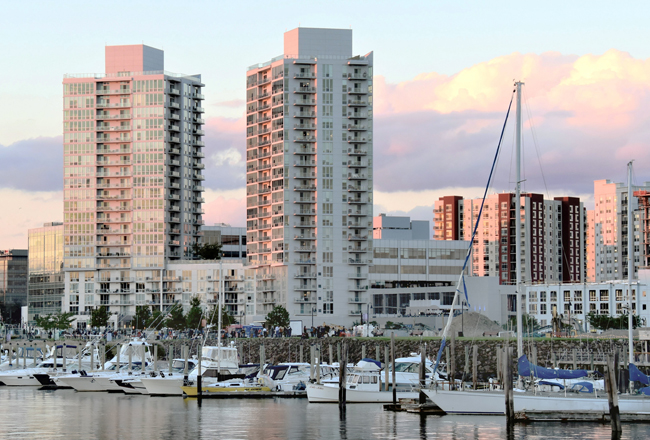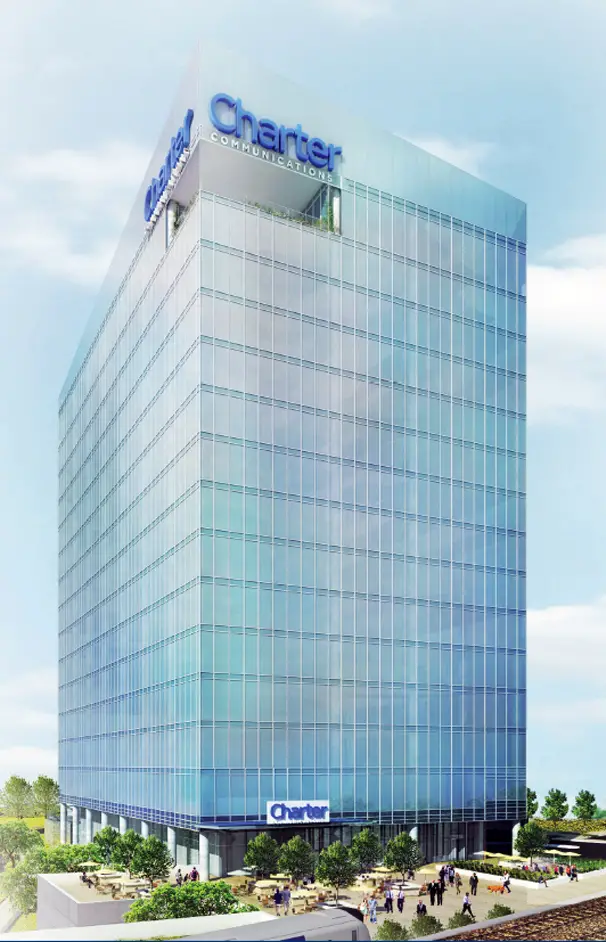Stamford’s Harbor Point at 10 years: Thumbs up from most stakeholders
Reflecting on the 10 years he”™s been involved with the massive $3.5 billion Harbor Point mixed-use development in Stamford, Building & Land Technology (BLT) Chief Operating Officer Ted Ferrarone said: “Looking back 10 years later at the original master plan, which was pretty ambitious and speculative, it”™s remarkable how much of it has been realized.”
It has indeed been quite a journey for both the redevelopment district and the city. What was once a heavily industrial waterfront site ”” one marked by pollution and high crime rates ”” is now a Leadership in Energy and Environmental Design (LEED) gold-certified, transit-oriented development encompassing over 100 acres of property.
The development consists of more than 6 million square feet of floor space, including 3,000 units of residential housing and numerous retail, office and commercial tenants, including an 88,000-square-foot Fairway Market that opened in 2010 at 699 Canal St.
“We”™ve brought in 30 new restaurants, created thousands of new jobs, had the parks rebuilt,” Ferrarone said. “It”™s really a vibrant area now.”
 When BLT acquired the property in 2007 from the now-defunct Antares Investment Partners of Greenwich, “There were about a thousand housing units and five big, vacant industrial lots throughout the neighborhood,” Ferrarone said. “It was basically a bunch of brownfields that paid no taxes.”
When BLT acquired the property in 2007 from the now-defunct Antares Investment Partners of Greenwich, “There were about a thousand housing units and five big, vacant industrial lots throughout the neighborhood,” Ferrarone said. “It was basically a bunch of brownfields that paid no taxes.”
But, he said, BLT saw plenty of opportunity in the space: facing a waterfront of roughly one mile, positioned a few blocks from the Stamford train station, and just south of downtown Stamford.
“The neighborhood had seen such little investment in the 50 years prior” to BLT”™s involvement, Ferrarone said.
“It was an area with a huge amount of waste,” agreed Stamford Director of Economic Development Thomas Madden. “You had the smells and the seagulls and everything else. BLT has done a lot to change the whole neighborhood, and it”™s helped the city along the way.”
That impact isn”™t just aesthetic, Madden said: “Assessments last year for Harbor Point were $21 billion, and that”™s up from the $19 billion the previous year. In terms of what had been there, it”™s been huge.”
Madden said those figures “are on track with what we were expecting, especially in light of the Great Recession [of 2007-09] and what we used to have there.”
Madden said Harbor Point and the South End neighborhood within which it stands have also been a positive in drawing businesses from New York City and other areas.
“There are real opportunities for investors there,” he said. “We (recently) met with a company from Toronto that”™s looking at a building there, and we”™re in ongoing talks with people and companies from New York City who want to get in on the ground floor.”
Terry Matthews, owner of the Harbor Point Wine & Spirits at 130 Washington Blvd. ”” who lives within a block of her store ”” said she”™d met numerous New York City transplants in the neighborhood.
“They”™re people who were used to living in a small space for twice the money than they have to pay up here,” she said. “And the train station is just a couple of blocks away. It”™s a one-train ride away from New York City.”
Having formerly lived in Greenwich, where she used to own the now-85-year-old Horseneck Wine and Spirits, Matthews said she”™s also noticed “more and more people moving here from Greenwich and places like Bedford ”” they”™re finding Harbor Point and moving in and loving it.”
Matthews said that BLT has been careful to help establish “a community where there”™s a camaraderie, everyone wants to meet people and do things together. They have created a phenomenal spot.”
Todd Kosakowski, a fixture on the area”™s restaurant scene who co-owns The Sign of the Whale at 6 Harbor Point Road, agreed.
“We couldn”™t be happier with how things are going,” he said. “I”™ve owned other restaurants in Stamford going back 14, 15 years, so I”™ve been very aware of the gentrification of Stamford.”
Prior to the Harbor Point development, he said, “Nobody would even think of going to the South End. But we watched what was happening, the evolution of it, and knew we wanted to be a part of it ”” that this was the future of Stamford.”
Kosakowski said the 10,000-square-foot, two-story restaurant employs 120 people during the summer months ”” when its rooftop bar is a popular attraction ”” and “probably 40 to 45” the rest of the year. Sign of the Whale regularly draws customers “from as far away as 35 to 40 miles,” he said. “It”™s a great environment that almost feels like a vacation destination.”
Free and ample parking helps, Kosakowski said. “BLT has followed through with the things they”™ve said they would do,” he declared. “This is the direction the area needed to go in.”
For all that, BLT”™s Harbor Point efforts have not been entirely without controversy, including:
Ӣ Labor union members have picketed various sites over the years over alleged violations and unfair practices.
”¢ Environmental group Soundkeeper sued the Stamford Zoning Board for what it charged was a violation of legally required compliances with environmental, coastal management and local zoning laws ”” a case that was dismissed in October by a state Superior Court judge.
Ӣ The saga of longstanding BrewerӪs Yacht Haven West, demolished in favor of Hinckley Boat Yard, which opened in June.
Ӣ Some residentsӪ repeated objections to what they see as out-of-control overdevelopment.
The most recent of those complaints revolves around BLT”™s plans for the former B&S Carting site on Woodland Avenue. The developer has amended what it wants to do to the property several times. The latest involves turning the one-time garbage transfer station into a complex of 540 housing units, including affordable housing.

Opponents maintain in part that BLT is exceeding its remit and essentially overdeveloping downtown, to the point where it”™s pricing out residents who have lived there for years.
But BLT has been gathering letters to the Stamford Planning and Zoning boards from numerous Harbor Point businesses in favor of its proposal, which requires amending Stamford”™s master plan to allow for higher-density housing.
“I have been a business owner in the South End for eight years now,” wrote Michael Gorman, owner of health and wellness treatment center Remedy Bodyworks at 36 Dyke Lane, “and have watched as new development has brought new life and vitality to the neighborhood.”
A 435-unit apartment building on Pacific Street is expected to open in the spring, while construction on the new Charter Communications corporate headquarters ”” a 500,000-square-foot building at 406 Washington Blvd. ”” is scheduled to be completed in 2020.
According to the U.S. Census Bureau, the South End”™s population increased by about 1,550 people between 2009 and 2016 ”” a figure that is bound to continue growing.
“It”™s remarkable what we”™ve developed here,” Ferrarone said. “There are a lot of younger people ”” young professionals, singles and couples ”” but an increasing number of downsizers and empty-nesters as well. It”™s a very broad spectrum of demographics in terms of age and income.”